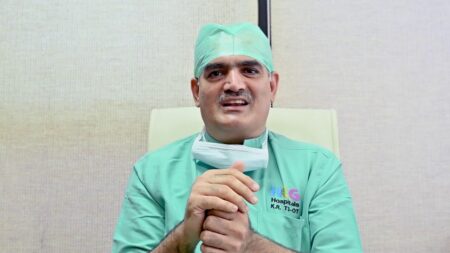Avascular necrosis among younger population Post COVID Era
Dr. Rewat Laxman, Senior Consultant- Orthopaedics Sports Injury & Joint Replacement, Manipal Hospital Sarjapur Avascular necrosis (AVN) is a hip condition that occurs due to the reduced blood supply to the joint, leading to bone death

Dr. Rewat Laxman, Senior Consultant- Orthopaedics Sports Injury & Joint Replacement, Manipal Hospital Sarjapur
Avascular necrosis (AVN) is a hip condition that occurs due to the reduced blood supply to the joint, leading to bone death and eventual collapse of the hip joint. It affects a large number of patients globally and poses a significant challenge to both patients and healthcare providers. Steroid-induced AVN of the hip joint has increased of late, especially after the COVID-19 pandemic, due to widespread steroid use as a life-saving drug. There was a 20 – 30 % spike in cases of AVN post-COVID times according to the health experts.
In most cases, it is not that easy to identify the condition, but there are various risk factors that can cause AVN which include alcohol, sickle cell anemia, smoking, and long-term use of steroids.
The cases spiked suddenly post-2020 when there were many patients complaining of hip pain and after investigating the condition was when it was figured AVN of the head of the femur. Most of the complaints were about back pain which was originally triggered by hip joints.
The pain usually spreads from the back to the lower limbs and is further felt till the foot. In some cases, the pain is felt from the hip to the front side of the thigh and radiates to the knee. This was earlier seen in the older population but now it is observed in the age group of 20-40 years of age. According to the experts, it’s seen widely among males compared to women. To manage the condition one must undergo anti-inflammatory medication and physical therapy and the severe condition through surgical intervention.
There are 4 stages of Avascular necrosis and the treatment method is decided based on the stages. In most cases, people tend to neglect the pain until the condition gets severe. To an extent, lifestyle changes can help in reducing weight, and constant exercise to improve the muscles around the hip on a regular basis can help manage the condition. Hence, early detection is the key, however, late detection can be treated with hip replacement procedures.
There are other options Autologous cultured osteoblast implantation which is known to be a novel and promising procedure that can help in the treatment of AVN of the hip.
Autologous cultured osteoblast implantation involves the use of the patient’s own bone-forming cells (osteoblasts) to form new bone tissue in the affected area. This procedure begins with the extraction of a small amount of bone marrow from the patient’s Posterior superior Illiac Spine. The osteoblasts are then isolated and cultured in a laboratory to increase their numbers. The cultured osteoblasts are then implanted into the area of the damaged hip joint, after a core decompression surgery where they start to form new bone tissue.
The key benefits of autologous cultured osteoblast implantation include the use of the patient’s own bone-forming cells, which reduces the risk of rejection, infection, and other complications. Additionally, the procedure involves minimally invasive surgery, which leads to a faster recovery time. Studies have shown that autologous cultured osteoblast implantation is highly effective in the treatment of AVN of the hip and can lead to a significant improvement in pain relief, mobility, and quality of life for patients.
It offers hope to patients suffering from this condition and can help to significantly improve their quality of life.






